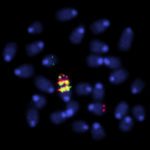Lien vers Pubmed [PMID] – 24050180
Annu. Rev. Genet. 2013;47:433-55
DNA double-strand breaks (DSBs) are common lesions that continually threaten genomic integrity. Failure to repair a DSB has deleterious consequences, including cell death. Misrepair is also fraught with danger, especially inappropriate end-joining events, which commonly underlie oncogenic transformation and can scramble the genome. Canonically, cells employ two basic mechanisms to repair DSBs: homologous recombination (HR) and the classical nonhomologous end-joining pathway (cNHEJ). More recent experiments identified a highly error-prone NHEJ pathway, termed alternative NHEJ (aNHEJ), which operates in both cNHEJ-proficient and cNHEJ-deficient cells. aNHEJ is now recognized to catalyze many genome rearrangements, some leading to oncogenic transformation. Here, we review the mechanisms of cNHEJ and aNHEJ, their interconnections with the DNA damage response (DDR), and the mechanisms used to determine which of the three DSB repair pathways is used to heal a particular DSB. We briefly review recent clinical applications involving NHEJ and NHEJ inhibitors.
